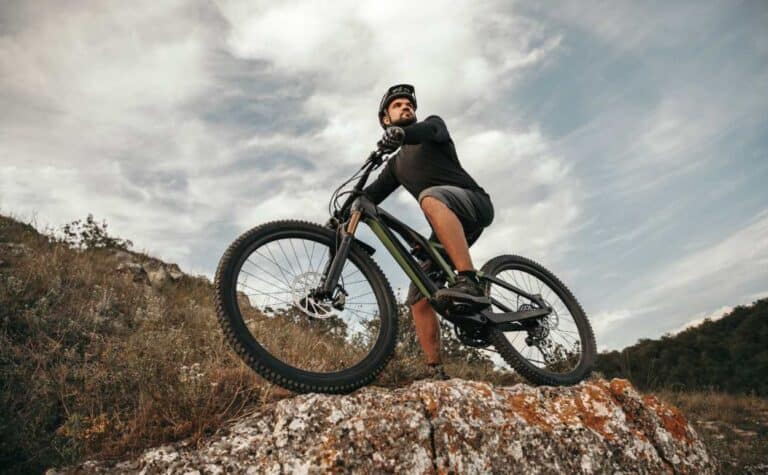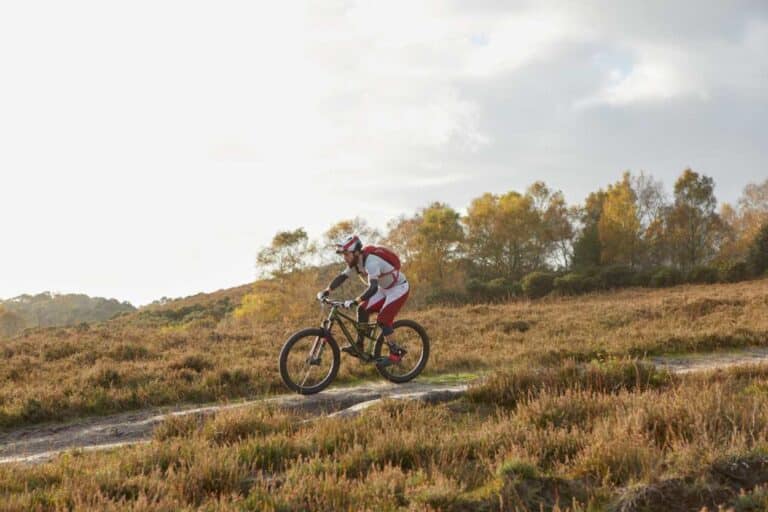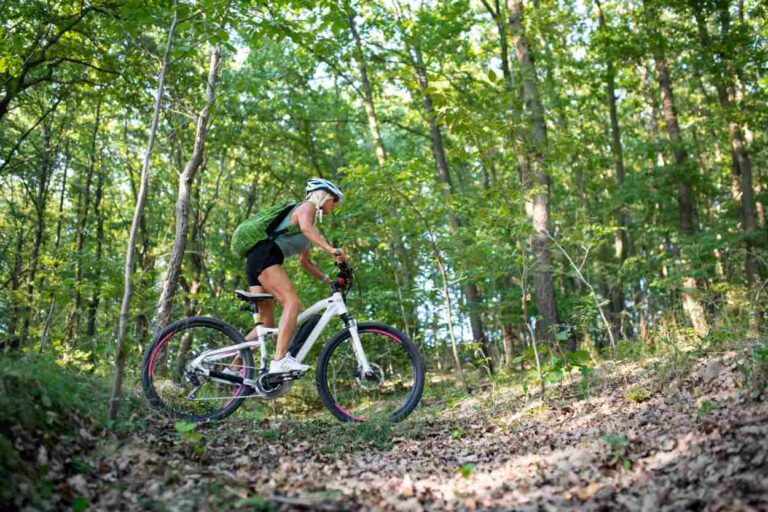E-mountain biking is having more than just a moment in the UK, it’s rapidly becoming one of the country’s fastest-growing outdoor activities. Whether its older riders getting back into the saddle, families exploring the countryside together, or seasoned mountain bikers embracing the extra power for longer, tougher rides, electric mountain bikes (e-MTBs) are making a huge impact on the scene.
In fact, UK e-bike sales topped over 165,000 units in 2023, and that number is only rising – searches for “e-mountain bike” are up by over 60% year-on-year, according to Google Trends. The electric bike market overall is expected to reach a value of £1 billion by 2030, with off-road and mountain models leading the charge.
E-MTBs now account for a significant portion of bike sales at major UK retailers, and trail centres across England, Wales, and Scotland are increasingly catering to e-bike users with charging stations, rentals, and even dedicated e-MTB routes. As of 2024, it’s estimated that over 350,000 riders in the UK now own or regularly ride electric mountain bikes.
So, if you’ve been curious about the e-MTB trend or are looking for new places to explore with one, this guide covers the UK’s best trails, typical costs to safety, gear protection, and what’s fuelling the surge in popularity.
Why are so many riders turning to E-mountain bikes?

The e-MTB boom isn’t just about the tech, it’s about what that tech enables. More and more riders are discovering the freedom, confidence, and pure fun that comes with electric assistance on the trails. Here’s why e-mountain biking is winning so many people over:
They open up mountain biking to more people
One of the biggest draws is accessibility. Not everyone has the time or ability to train for steep, leg-burning climbs. E-MTBs make it possible for riders with reduced fitness levels, health conditions, or mobility issues to enjoy mountain biking again – or even for the first time.
They make riding more accessible
Whether you’re coming back from injury, getting older, or just want to enjoy the trails without exhausting yourself, an e-bike lets you ride more with less effort. You can squeeze in a decent ride after work or do back-to-back trail loops without worrying about burning out.
Uphill becomes more fun
Traditionally, climbs were just something to endure before getting to the good bits. With an e-MTB, climbs become enjoyable in their own right – more like a challenge than a chore. You’ll find yourself taking on hills you’d usually avoid, knowing you’ve got a bit of backup under your pedals.
You can ride further
The battery assist gives you the power to go longer distances without the same level of fatigue. That means more time exploring new trails, tackling epic loops, or linking together trail centres that would usually be out of range on a traditional bike.
Perfect for mixed-ability groups
One of the underrated benefits of e-MTBs is how well they suit mixed-ability groups. Friends, partners, or families with different fitness levels can ride together without constant stopping or splitting up. Everyone gets a good ride – and no one feels like they’re holding the group back.
Top e-mountain biking destinations in the UK

One of the best things about e-MTBing in the UK is the sheer variety of trail centres and natural routes on offer. Here are some standout spots to check out:
Swinley Forest, Bracknell
Situated just outside London, Swinley Forest is a great all-rounder with waymarked trails through pine woodland. It’s a popular spot for both beginners and seasoned riders looking to get a few laps in.
Trail distance: Approx. 24 km of marked trails
Trail grades: Green (easy), Blue (moderate), Red (difficult)
Best for: Beginners to intermediate riders
The Blue and Red routes are ideal for e-bikes, with long gradual climbs and flowing descents. The forest’s compact layout means you can easily do multiple loops on a single charge.
Cannock Chase, Staffordshire
A great Midlands option, Cannock Chase offers well-built trails with technical features, forest scenery, and a relaxed vibe. Popular with weekend warriors and beginners getting into the sport.
Trail distance: Follow the Dog (11 km), Monkey Trail (21 km)
Trail grades: Blue and Red
Best for: Intermediate riders
The rolling terrain suits e-MTBs perfectly, and both major trails can be linked for a longer, more challenging ride. The on-site café and bike hire centre make it a convenient day out.
Forest of Dean
A friendly, well-developed trail centre with something for everyone – from gentle family trails to technical enduro lines. It’s one of the most accessible spots for trying out an e-MTB.
Trail distance: Blue Verderers’ Trail (11 km), Red Freeminers Trail (12 km), plus loads of off-piste lines
Trail grades: Green to Black
Best for: All abilities
The Verderers’ Trail is flowy and fast, ideal for e-MTBs. The Freeminers Trail adds in more tech and challenge. There’s also a dedicated uplift for downhill runs if you fancy mixing it up.
Llandegla, North Wales
One of the most popular trail centres in Wales, Coed Llandegla is purpose-built with great facilities, making it very e-bike friendly. Expect wide fire road climbs, twisty singletrack descents, and plenty of variety.
Trail distance: Up to 21 km per loop
Trail grades: Green (easy), Blue (moderate), Red (difficult), Black (expert)
Best for: All abilities
The Red route is a favourite for e-MTB riders with steady climbs and thrilling, berm-filled descents. There’s also an e-bike hire shop and charging points on-site.
Bike Park Wales
The UK’s first full-scale mountain bike park, BikePark Wales is a downhill paradise with over 40 trails. There’s an uplift service, but many riders now use e-MTBs to lap the hill at their own pace.
Trail distance: 40+ downhill trails, typically 1–2.5 km each
Trail grades: Blue (moderate) to Pro Lines (elite)
Best for: Confident intermediate to advanced riders
E-MTBs are ideal here for avoiding uplift queues and clocking more laps. Just bear in mind: the trails are fast and can be rough – full suspension is a must.
Forest of Ae, Scotland
Often overlooked, Forest of Ae is a brilliant Scottish trail centre with fast, flowing singletrack and less foot traffic than better-known spots.
Trail distance: Red route (24 km), Ae Line (27 km), various loops
Trail grades: Blue, Red, Black
Best for: Intermediate and advanced riders
It’s a superb location for e-MTBs, with long forest road climbs and rewarding descents that make the most of your bike’s suspension and power.
Glentress Forest, Scotland
Arguably the crown jewel of Scottish trail centres. Glentress offers stunning riding for all levels, from family loops to technical enduro lines, all set in beautiful Borders scenery.
Trail distance: Green (3.5 km), Blue (16 km), Red (18 km), Black (29 km)
Trail grades: Green to Black
Best for: All riders, from families to seasoned pros
The climbs are long but steady – perfect for e-bikes – and the descents are fast, varied, and packed with features. On-site hire, e-bike charging, a café and a bike shop round out the experience.
What does E-Mountain biking cost?
Getting into e-mountain biking isn’t cheap, especially compared to a standard mountain bike, but there are options for almost every budget. While you can pick up a capable hardtail mountain bike for £500–£1,500, a decent e-MTB will cost significantly more due to the motor, battery, and extra engineering involved.
Buying a bike
A good entry-level e-MTB will set you back around £2,000–£3,000, typically with front suspension (hardtail), a reliable motor from brands like Bosch, Shimano, or Specialized, and a mid-range battery capacity.
High-end, full-suspension models, often used by experienced riders tackling technical terrain, can easily hit £6,000–£8,000, with premium suspension, carbon frames, and batteries that last 70–100km on a single charge.
Considering second-hand
Buying second-hand can be a smart way to save money – sometimes by as much as 30–50% off retail – but it’s worth doing your homework. When shopping for a used e-MTB:
- Check battery health – Many batteries lose capacity over time; ask the seller for the number of charge cycles or have it tested at a shop.
- Inspect the motor – Listen for unusual noises and check that assistance modes work correctly.
- Look at service history – Regular maintenance (including firmware updates) is important for motor longevity.
- Buy from a reputable source – Specialist e-bike retailers, trail centre hire fleets, and certified resellers often refurbish and offer warranty with their used stock.
Second-hand is particularly good for riders who aren’t yet sure how much they’ll use their e-MTB and don’t want to invest top-end money up front.
Hiring
Many UK trail centres now offer e-bike hire from around £40 to £80 per day, depending on the model. This is perfect for testing the waters before committing to a purchase, or for occasional riders who just want a powered day out on the trails without the cost of ownership.
Running costs
Charging is inexpensive – a full battery top-up costs roughly 10–20p at home. However, servicing and parts are typically more expensive than a standard mountain bike due to the added complexity. Keep a bit aside for:
- Motor checks and servicing
- Drivetrain replacements (chains, cassettes, chainrings)
- Brake servicing (heavier bikes wear pads and rotors faster)
- Firmware/software updates for the motor system
Safety tips for E-Mountain biking

Even with pedal assistance, e-MTBs can be just as gnarly – if not more – than regular mountain bikes. Here’s how to stay safe:
- Always wear a helmet. On technical trails, a full-face lid is worth considering.
- Ride within your limits. E-bikes can make it easy to get in over your head.
- Learn how to manage your battery – don’t blast boost mode early unless you’re planning a short ride.
- Check trail conditions and weather – some routes become very sketchy when wet, even with powered assistance.
Protecting your gear
E-MTBs are valuable bits of kit and unfortunately, thieves know it. Here’s how to keep yours safe:
- Use a high-quality lock (look for gold-rated options).
- If transporting the bike in a vehicle, always remove the battery and store it separately.
- Consider specialist cycling insurance that covers theft, damage, and make sure e-bikes are included.
- Use a rack designed to carry heavier electric bikes if you’re transporting them by car.
E-bike maintenance
E-bikes need a bit more TLC than standard mountain bikes, particularly when it comes to the motor and drivetrain.
- Keep it clean – the extra torque can wear out parts faster.
- Update your firmware if your motor brand requires it (Bosch, Shimano, etc.).
- Avoid storing the battery fully flat or fully charged – around 60% is ideal for long-term storage.
Best time to ride?
Spring to early autumn is peak riding season, but many trails are rideable year-round with the right gear. That said, e-bikes do handle mud and slippery conditions better than regular bikes, but winter riding can be tough on the components, so prep accordingly.
E-mountain biking is opening up the sport to more people than ever before – and making it even more fun for those already hooked. Whether you’re looking for scenic trail rides, technical challenges, or just a boost up the hills, there’s never been a better time to give it a go.
Secure specialist cycling insurance from SportsCover Direct
SportsCover Direct’s cycling insurance has been designed to give protection for cycling in the UK or cycling abroad.
Our cycling travel insurance covers you abroad, whether you’re enjoying the sport for leisure or cycling competitively. It offers cover for medical costs, equipment, cancelled trips and more. If you already have travel insurance, our bolt-on allows you to add the protection you need for cycling. You can also opt for our sports accident insurance, which has been created to protect you while cycling in the UK.
Choose Sports Accident cover to protect against personal liability, equipment and injuries whilst in the UK.
Find out more and get an instant quote designed to suit you.
This blog has been created as general information and should not be taken as advice. Make sure you have the correct level of insurance for your requirements and always review policy documentation.